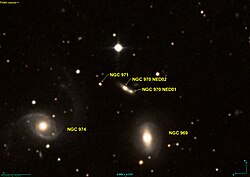| NGC 970 | |
|---|---|

DSS image of NGC 970 | |
| Observation data ( J2000 epoch) | |
| Constellation | Triangulum |
| Right ascension | 02h 34m 11.69897s [1] |
| Declination | +32° 58′ 38.3137″ [1] |
| Redshift | 0.03270 [2] |
| Heliocentric radial velocity | 9642 km/s [2] |
| Distance | 471.4 Mly (144.54 Mpc) [3] [note 1] |
| Apparent magnitude (B) | 15.66 [3] |
| Characteristics | |
| Type | S: [4] |
| Other designations | |
| MCG +05-07-009, PGC 9786 [2] | |
NGC 970 is an interacting galaxy pair in the constellation Triangulum. It is estimated to be 471 million light-years [3] [note 1] from the Milky Way and has a diameter of approximately 100,000 ly. The object was discovered on September 14, 1850, by Bindon Blood Stoney. [5] [6] [4]
See also
Notes
References
- ^ a b Brown, A. G. A.; et al. (Gaia collaboration) (August 2018). "Gaia Data Release 2: Summary of the contents and survey properties". Astronomy & Astrophysics. 616. A1. arXiv: 1804.09365. Bibcode: 2018A&A...616A...1G. doi: 10.1051/0004-6361/201833051.
- ^ a b c "NGC 970". SIMBAD. Centre de données astronomiques de Strasbourg. Retrieved 2020-05-30.
- ^ a b c "Search specification: NGC 970". HyperLeda. Université Claude Bernard Lyon 1. Retrieved 2020-05-30.
- ^ a b Seligman, Courtney. "New General Catalogue objects: NGC 950 - 999". cseligman.com. Retrieved 2021-02-17.
- ^ "Your NED Search Results". ned.ipac.caltech.edu. Retrieved 2020-02-12.
- ^ "Revised NGC Data for NGC 970". spider.seds.org. Retrieved 2020-02-12.